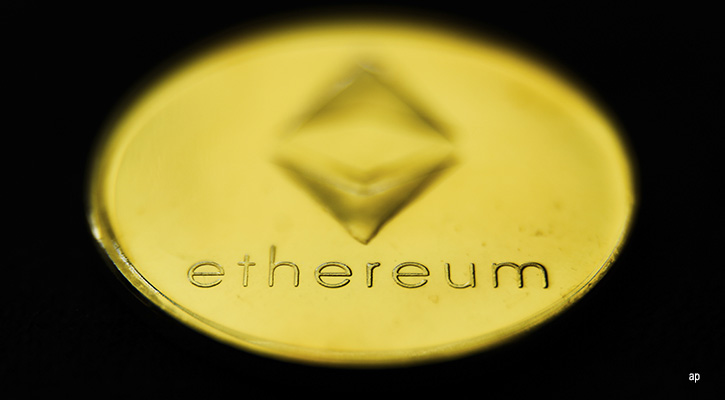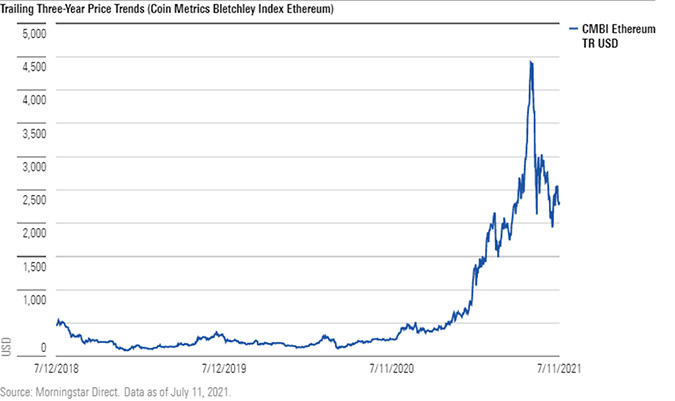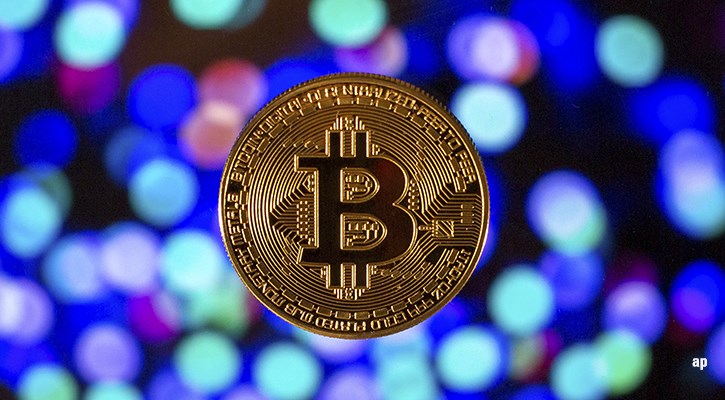
If you're still getting up to speed on the cryptocurrency space, you've probably heard of Ethereum, which ranks as the second-largest cryptocurrency after Bitcoin (new to bitcoin? Read this first). This article will explain some of the basics of the Ethereum protocol – I'll discuss Ether as an investment asset in my next article.
As the chart below illustrates, Ether (the official name of the cryptocurrency) is an extremely volatile asset from an investment perspective, even compared with bitcoin. But Ethereum (the broader term for the protocol that enables decentralised finance applications through smart contract functionality) is worth knowing about because of its potential to revolutionise the entire financial landscape.
That means even those who decide not to invest in ether will likely be affected by Ethereum in some way.

Ethereum 101
Ethereum is a decentralised network of computers envisioned as the next-generation version of the Internet (also known as Web 3.0). Founder Vitalik Buterin envisioned it as an open-source platform that can execute smart contracts without relying on a centralised institution as a trusted intermediary. It's designed to avoid many of the key shortcomings of Web 2.0: A handful of large companies control development systems and data centres, which limits development, centralises trust, and introduces single points of failure.
Ethereum is designed to execute contracts and transactions, which enables it to function as a platform for building and running software applications. Because its functionality is well-suited for financial operations, it's often described as programmable money, or, in Lyn Alden's apt description, as an operating system with a side of money.
Ethereum promises to revolutionise the entire financial system because of its potential applications in so many different areas from smart contracts, to so-called DeFi (decentralised finance), and NFTs (we've previously written on what are NFTs and why they are so valuable and asked whether NFTs are hurting the environment).
Ether vs. Bitcoin
Ether fills a unique role in the cryptocurrency space. While Bitcoin mainly serves as a digital currency and store of value (though some investors say Bitcoin is the new gold), Ether also functions as a utility. It's often described as digital oil or digital gas because it's used to fuel computing power on the network, execute smart contracts, and compensate the miners who validate and verify transactions to add to the blockchain. (The Ethereum blockchain is a decentralised ledger that maintains a transparent record of every transaction and computation, eliminating the need for third-party verification.)
At a basic level, Ether is somewhat similar to Bitcoin. Both are digital currencies secured by cryptographic puzzles that can be used for peer-to-peer payments. Both require some type of digital wallet as proof of ownership.
But Ether has a much broader use case because of its programmability and critical role in decentralised finance. As a result, 30-day asset flows for ether have recently been close to 10 times as high as those for Bitcoin. Ether circulates more frequently, about 68% of the currency's supply was classified as active over the past 12 months, compared with only 46% for bitcoin.
An initial set of 72 million ether was created when the Ethereum network was first launched in 2015. Unlike Bitcoin, which has a hard supply limit of 21 million coins, there's currently no cap on the amount of ether outstanding.
Supply and Demand
But the supply dynamics for ether will dramatically change with the advent of Ethereum Improvement Protocol 1559, scheduled to be implemented in August. EIP 1559 is designed to significantly reduce transaction costs.
Transaction costs are currently set by an auction system that often results in higher fees during periods of higher demand or network congestion. EIP 1559 will replace this system with one that uses the network to set prices automatically. At the same time, it will "burn" a small amount of ether whenever someone makes a transaction, effectively reducing ether's supply and increasing its value over time. This deflationary dynamic has led to the meme that if bitcoin is sound money, ether should be considered ultrasound money.
Ethereum 2.0 is another major upgrade currently being implemented. One of the major changes involves switching the security architecture from proof of work to proof of stake. Proof of work means using a high-powered computer to test a series of algorithms, or hashing functions, to validate and confirm transactions. It relies on trial and error to generate a random series of numbers and letters until the program comes up with one that matches the original value. Proof of work is highly secure, but also massively inefficient because it requires so much computing power and electricity.
Staking Rewards
Proof-of-stake algorithms, on the other hand, are significantly more efficient and less resource-intensive. People can lock up, or stake, a certain amount of ether to help validate transactions on the network. In exchange, they receive staking rewards. Because mining power is granted randomly based on the number of coins held in a node, it reduces the number of computations required to validate transactions. Many observers estimate that the shift from proof-of-work to proof-of-stake will reduce Ethereum's energy usage by at least 1,000-fold. It should also make the network more efficient by increasing the number of transactions per second. The Ethereum community is also planning subsequent improvements, including zk-SNARKs, rollups, and sharding, each of which has the potential to further boost energy efficiency and transaction volume.
Finally, ether currently has two different forms. In a 2016 hacking incident, an attacker broke into a decentralised venture capital firm built on the Ethereum blockchain and stole $60 million of ether. The Ethereum community voted to create a "hard fork" to restore the network and recapture the stolen funds. This fork created two different versions of the blockchain: Ethereum Classic (the pre-fork version) and Ethereum (the post-fork version). Each network has its own corresponding version of ether, although the classic ether is more of a legacy currency that's no longer widely used.
I've only lightly scratched the surface of Ethereum here. In my next article, I'll take a closer look at Ether as an investment asset.



























